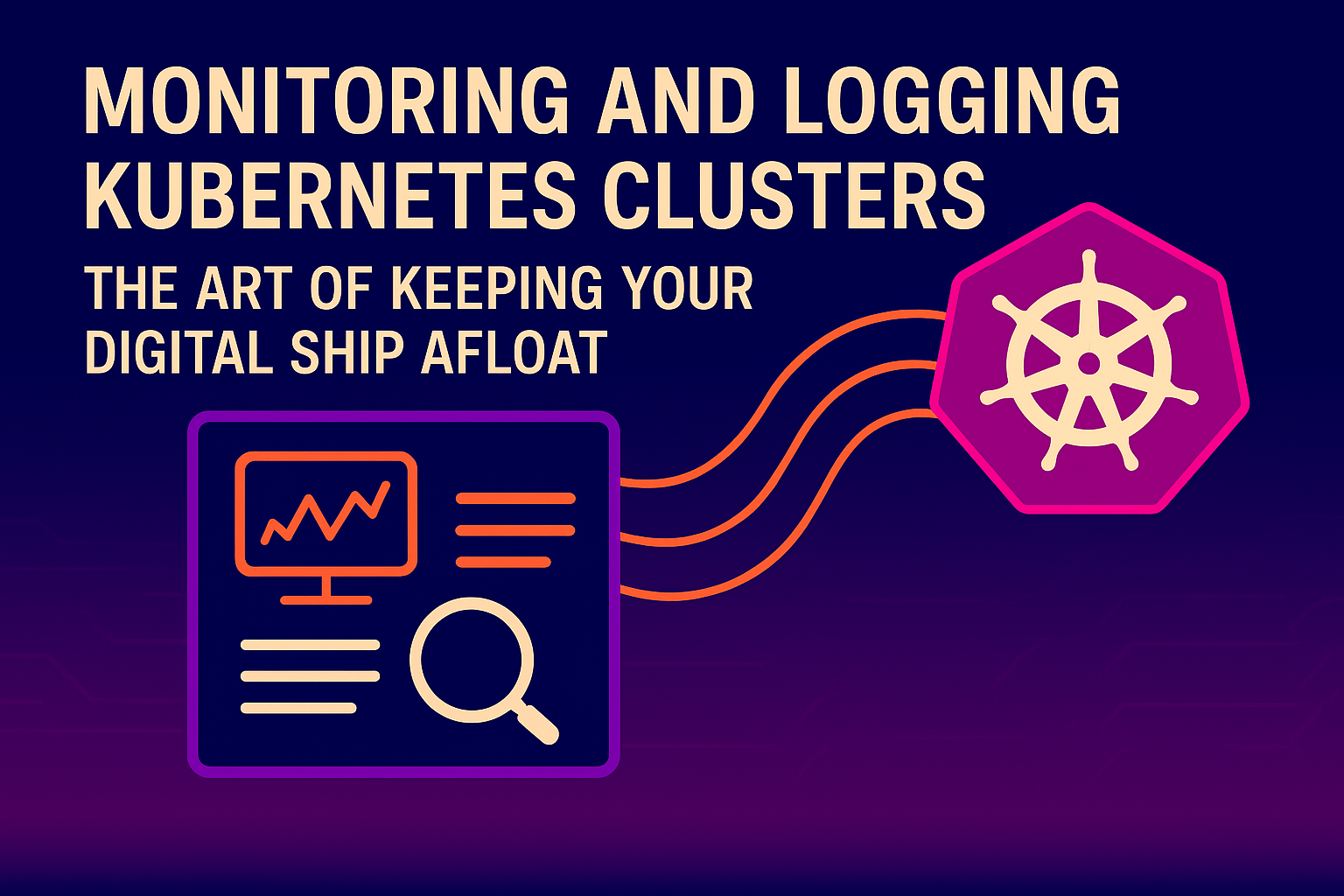Part 8 - Monitoring and Logging Kubernetes Clusters: The Art of Keeping Your Digital Ship Afloat
In the wild seas of Kubernetes, monitoring and logging are your radar and compass—ignore them, and you’re just waiting to crash in the dark.

Picture this: You're sailing the vast ocean of cloud-native applications, your Kubernetes cluster humming along like a well-oiled machine. Everything seems perfect until 3 AM when your phone buzzes with alerts that your e-commerce site is down during peak traffic from overseas customers. You frantically open your laptop, but where do you even begin? Without proper monitoring and logging, you're essentially navigating without a compass, radar, or even a weather report. This scenario plays out countless times across organizations worldwide, making monitoring and logging not just nice-to-have features, but absolute necessities for any serious Kubernetes deployment.
The Foundation: Understanding Why Monitoring Matters in Kubernetes
Kubernetes environments present unique challenges that traditional monitoring approaches simply cannot handle effectively. Unlike monolithic applications running on single servers, Kubernetes orchestrates hundreds or thousands of ephemeral containers across multiple nodes, with pods appearing and disappearing based on demand. The dynamic nature of container orchestration means that traditional host-based monitoring falls short when trying to track the health and performance of distributed microservices.
Modern Kubernetes monitoring requires a comprehensive strategy that encompasses multiple layers of the infrastructure stack. As organizations increasingly adopt microservices and distributed architectures, practical monitoring tools and methodologies become essential for maintaining exceptional workload performance and high availability. The complexity inherent in Kubernetes deployments necessitates monitoring solutions that can adapt to the ephemeral nature of containers while providing meaningful insights into application behavior.
Effective Kubernetes monitoring involves tracking various components including nodes, pods, containers, and services, as well as the overall cluster health. This multi-dimensional approach ensures that administrators can identify resource constraints, service failures, and application crashes before they impact users or business operations. Rather than simply measuring individual containers, successful monitoring strategies focus on service-level and application-level metrics to provide a complete view of application health.
Prometheus: Your Cluster's Health Detective
Enter Prometheus, the Swiss Army knife of Kubernetes monitoring that has become the de facto standard for cloud-native observability. Prometheus operates as a powerful open-source monitoring system that collects metrics from Kubernetes pods and nodes, enabling real-time monitoring of resource utilization, performance metrics, and application health. What makes Prometheus particularly valuable for Kubernetes environments is its native understanding of the platform's dynamic nature and its ability to automatically discover new services and endpoints.
The architecture of a Prometheus-based monitoring stack typically includes the Prometheus server itself, Alertmanager for handling notifications, and Grafana for visualization. This combination creates a comprehensive monitoring ecosystem that can handle the complexities of modern containerized environments. The Prometheus server scrapes metrics from various targets using a pull-based model, storing time-series data that can be queried using PromQL, its powerful query language.
Setting up Prometheus on Kubernetes involves creating the necessary RBAC permissions, deploying the Prometheus server, and configuring service discovery to automatically monitor your cluster components. The beauty of this approach lies in its automation capabilities—once configured, Prometheus will automatically discover new services and endpoints through Kubernetes service discovery mechanisms, eliminating the need for manual configuration updates as your infrastructure evolves.
Performance comparisons reveal that Prometheus-based monitoring can significantly impact system behavior. Research shows that horizontally scaled systems monitored by Prometheus demonstrate 18.48% higher CPU utilization compared to non-monitored systems, while achieving 65.60% lower response times. This data illustrates how proper monitoring infrastructure can actually improve application performance by enabling better resource allocation and faster issue resolution.
Grafana: Painting Pictures from Your Data
While Prometheus excels at collecting and storing metrics, Grafana transforms those metrics into visually compelling and actionable insights. Grafana serves as the visualization layer that makes sense of the vast amounts of data flowing through your Kubernetes cluster, providing customizable dashboards that offer clear visualizations of CPU, memory, network, and other essential metrics. These visualizations enable quick identification of resource bottlenecks and performance issues in Kubernetes deployments.
Grafana's integration with Prometheus creates a powerful combination for Kubernetes monitoring. The platform seamlessly connects with Prometheus as a data source, allowing administrators to create sophisticated dashboards that track everything from basic resource utilization to complex application performance indicators. Modern Grafana implementations can integrate with existing monitoring tools and allow customization of dashboards and alerts to fit specific organizational needs.
The real power of Grafana lies in its ability to correlate data from multiple sources and present it in contextually meaningful ways. For Kubernetes environments, this means creating dashboards that show not just individual metrics, but relationships between different components of your infrastructure. You can visualize how pod resource consumption affects node performance, or how application response times correlate with underlying infrastructure metrics.
Advanced Grafana configurations enable proactive alerting based on specific metric thresholds, ensuring administrators receive timely notifications of potential issues before they escalate into critical problems. This proactive approach to monitoring helps maintain healthy and performant Kubernetes clusters by enabling rapid response to emerging issues.
Logging: The EFK Stack and Modern Alternatives
While metrics tell you what happened, logs tell you why it happened. Traditional logging approaches struggle with Kubernetes environments due to the ephemeral nature of containers and the distributed architecture of microservices. This challenge has led to the development of centralized logging solutions that can aggregate logs from across the entire cluster into a single, searchable repository.
The EFK stack—consisting of Elasticsearch, Fluentd, and Kibana—has long been the standard solution for Kubernetes logging. This combination provides comprehensive log aggregation capabilities, with Fluentd collecting logs from pods across the cluster, Elasticsearch storing and indexing the log data, and Kibana providing a user interface for searching and visualizing logs. The EFK stack helps ensure that no loss of log data occurs when pods terminate, addressing one of the fundamental challenges of container-based logging.
However, the logging landscape has evolved significantly with the introduction of modern alternatives like Grafana Loki. Loki represents a paradigm shift in logging architecture, offering index-free scalability and horizontal scaling capabilities that provide high performance even with significant log ingestion volumes. Unlike traditional logging solutions that index the content of logs, Loki only indexes metadata labels, dramatically reducing storage requirements and improving query performance.
Loki's integration with the existing Prometheus and Grafana ecosystem creates a unified observability platform where administrators can view metrics and logs through a single interface. This integration simplifies operational workflows and reduces the complexity of managing multiple monitoring tools. The minimalistic architecture of Loki requires only a few components: a distributor that receives log writes, an ingester that pushes logs to backend storage, and a querier that responds to user queries via LogQL.
Implementation of centralized logging solutions demonstrates significant operational benefits. Research indicates that centralized logging systems provide unified views of logs from all deployments, facilitating easier troubleshooting and analysis while enabling automation of monitoring resource setup across different deployments. These systems become particularly valuable in complex environments where traditional approaches to log management become unwieldy.
Practical Implementation: Building Your Monitoring Infrastructure
The journey from concept to implementation requires careful planning and execution. Successfully deploying monitoring and logging infrastructure involves more than simply installing tools—it requires developing a comprehensive strategy that aligns with your operational needs and organizational constraints.
Starting with Prometheus deployment, the process involves creating dedicated namespaces, configuring RBAC permissions, and deploying the Prometheus server with appropriate resource allocations. Modern deployments typically use Helm charts to simplify the installation process and ensure consistent configurations across environments. When deploying on cloud platforms like AWS EKS, specific considerations around persistent storage and service exposure become critical for long-term operational success.
The configuration of monitoring targets requires careful attention to service discovery mechanisms. Prometheus can automatically discover Kubernetes services through built-in service discovery, but proper labeling and annotation strategies ensure that monitoring captures the right metrics from the right services. This automation reduces operational overhead while ensuring comprehensive coverage of your infrastructure.
Grafana deployment and configuration follows similar patterns, with emphasis on creating meaningful dashboards that provide actionable insights rather than simply displaying all available metrics. Effective dashboard design focuses on key performance indicators that align with business objectives and operational needs. This approach prevents information overload while ensuring that critical issues receive appropriate attention.
For logging infrastructure, the choice between traditional EFK stacks and modern alternatives like Loki depends on specific requirements around scale, complexity, and integration needs. Loki installations can be accomplished through single Helm charts, representing a Kubernetes-native approach to software installation that simplifies ongoing maintenance. The decision should consider factors like log volume, retention requirements, and integration with existing monitoring infrastructure.
Real-World Scenarios: When Theory Meets Practice
Consider the case of an e-commerce platform experiencing intermittent performance issues during peak traffic periods. Traditional monitoring might show elevated CPU and memory usage, but comprehensive Kubernetes monitoring reveals the complete picture. Prometheus metrics indicate that horizontal pod autoscaling is triggering correctly, but response times remain elevated. Detailed analysis of Grafana dashboards shows that while compute resources are scaling appropriately, database connection limits are becoming the bottleneck.
Log analysis through the EFK stack or Loki reveals specific error patterns in application logs that correlate with the performance degradation. Database connection timeout errors appear in clusters, indicating that the application layer is scaling faster than the database tier can accommodate new connections. This insight, impossible to obtain through traditional monitoring alone, enables targeted optimization of database connection pooling and scaling strategies.
Another common scenario involves debugging deployment failures in complex microservices architectures. When a new application version fails to deploy successfully, metrics alone provide limited insight into the root cause. However, comprehensive logging reveals dependency chain failures, configuration mismatches, or resource constraints that prevent successful pod initialization. The combination of metrics and logs enables rapid identification and resolution of deployment issues that could otherwise result in extended downtime.
Research demonstrates the effectiveness of integrated monitoring approaches in serverless and edge computing environments. Studies show that intelligent monitoring frameworks capable of recognizing and visualizing key operational scenarios in distributed environments can detect various situations including normal operation, overload conditions, error handling, and load balancing scenarios. These capabilities become essential for maintaining system reliability in complex distributed architectures.
Advanced Patterns: Alerting and Incident Response
Effective monitoring infrastructure extends beyond data collection and visualization to include proactive alerting and incident response capabilities. Alertmanager, the alerting component of the Prometheus ecosystem, handles alerts generated by Prometheus servers and routes them to appropriate receivers based on configured rules. This system processes alerts through grouping, deduplication, and routing mechanisms that prevent alert fatigue while ensuring critical issues receive immediate attention.
Modern alerting strategies focus on reducing noise while maintaining sensitivity to genuine issues. Research shows that effective alerting configurations can dramatically improve incident response times and reduce the operational burden on development and operations teams. The key lies in developing alerting rules that capture meaningful state changes rather than simply threshold breaches.
Alert routing and escalation policies become crucial in production environments where different types of issues require different response procedures. Alertmanager supports sophisticated routing configurations that can send different alert types to different teams, adjust notification methods based on severity levels, and implement escalation procedures that ensure critical issues receive appropriate attention.
Integration with incident response workflows transforms monitoring from a reactive tool into a proactive system that enables rapid response to emerging issues. Modern implementations often include integration with platforms like Slack, PagerDuty, or custom webhook systems that trigger automated response procedures for common issue types.
Performance Optimization and Scalability Considerations
As monitoring infrastructure matures, performance optimization becomes increasingly important. The monitoring system itself can become a resource consumer that impacts the applications it's designed to monitor. Understanding the performance characteristics of different monitoring approaches enables informed decisions about architecture and configuration choices.
Comparative analysis reveals significant differences between monitoring approaches in terms of resource consumption and system impact. Vertical scaling strategies for monitoring infrastructure can reduce CPU utilization by up to 49.45% compared to non-optimized deployments, while horizontal scaling approaches may increase CPU utilization but dramatically improve response times. These trade-offs require careful consideration based on specific operational requirements and resource constraints.
Storage considerations become particularly important for long-term monitoring infrastructure. Prometheus time-series data can grow rapidly in large environments, requiring strategies for data retention, compaction, and archival. Modern implementations often include tiered storage approaches that balance immediate accessibility with long-term cost efficiency.
Network overhead from monitoring infrastructure requires careful management, particularly in bandwidth-constrained environments. Optimizing scrape intervals, reducing metric cardinality, and implementing efficient labeling strategies can significantly reduce the network impact of monitoring infrastructure while maintaining observability coverage.
Security and Compliance in Monitoring Infrastructure
Security considerations for monitoring infrastructure often receive insufficient attention, despite the fact that monitoring systems typically have access to sensitive information about infrastructure and applications. Proper security implementation includes secure communication channels, appropriate access controls, and protection of sensitive data in metrics and logs.
Role-based access control (RBAC) becomes essential for monitoring infrastructure, ensuring that different teams and individuals have appropriate access to monitoring data without compromising security. This includes both read access to dashboards and metrics, as well as administrative access to monitoring infrastructure configuration.
Data sanitization in logs and metrics prevents inadvertent exposure of sensitive information like passwords, API keys, or personal data. Modern logging solutions include capabilities for automatic redaction or masking of sensitive data patterns, reducing the risk of security incidents while maintaining the utility of log data for troubleshooting and analysis.
Compliance requirements often mandate specific approaches to monitoring data retention, access logging, and audit trails. Understanding these requirements early in the monitoring infrastructure design process prevents costly retrofitting and ensures that monitoring solutions support rather than complicate compliance efforts.
The Evolution Continues: Emerging Trends and Future Directions
The monitoring and observability landscape continues to evolve rapidly, driven by changing infrastructure patterns and increasing operational complexity. OpenTelemetry represents one significant trend, providing standardized approaches to collecting and exporting telemetry data that reduce vendor lock-in and improve interoperability between monitoring tools.
Artificial intelligence and machine learning increasingly influence monitoring practices, with automated anomaly detection and predictive alerting becoming standard features in modern monitoring platforms. These capabilities promise to reduce alert fatigue while improving the accuracy of issue detection and root cause analysis.
Edge computing and IoT deployments present new challenges for monitoring infrastructure, requiring solutions that can operate effectively in resource-constrained environments while maintaining observability across distributed edge locations. These emerging use cases drive innovation in monitoring architecture and deployment patterns.
The integration of security monitoring with traditional observability creates comprehensive platforms that address both performance and security concerns through unified interfaces and workflows. This convergence reduces operational complexity while improving overall system reliability and security posture.
Your monitoring journey doesn't end with deployment—it evolves continuously as your infrastructure grows and your understanding of operational requirements deepens. The tools and practices outlined here provide a solid foundation, but the real value emerges from iterative improvement and adaptation to your specific operational context. Whether you're debugging a midnight outage or optimizing performance for the next traffic surge, robust monitoring and logging infrastructure transforms crisis management into confident problem-solving. Remember that the best monitoring system is the one your team actually uses effectively, so start simple, iterate frequently, and let your operational experience guide the evolution of your observability strategy.

